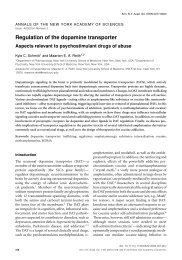The Role of Male Sexual Arousal in Rape: Six Models
The Role of Male Sexual Arousal in Rape: Six Models
The Role of Male Sexual Arousal in Rape: Six Models
Create successful ePaper yourself
Turn your PDF publications into a flip-book with our unique Google optimized e-Paper software.
Inhibition Model: Cues <strong>of</strong> Force and Violence as Inhibitory<br />
Barbaree et al. (1979) <strong>in</strong>terpreted their f<strong>in</strong>d<strong>in</strong>gs us<strong>in</strong>g an <strong>in</strong>-<br />
hibitory model <strong>of</strong> rape arousal. <strong>The</strong>y viewed the sexual stimu-<br />
lus as a compound stimulus. <strong>The</strong> compound stimulus <strong>in</strong>cluded<br />
the descriptions <strong>of</strong> sexual <strong>in</strong>teractions and physical aspects <strong>of</strong><br />
the woman <strong>in</strong> the vignette, and these sexual cues had the effect<br />
<strong>of</strong> <strong>in</strong>creas<strong>in</strong>g arousal. However, dur<strong>in</strong>g the rape descriptions,<br />
rape cues <strong>in</strong>clud<strong>in</strong>g descriptions <strong>of</strong>nonconsent, force, violence,<br />
and suffer<strong>in</strong>g <strong>of</strong> the victim were seen to serve, especially <strong>in</strong><br />
nonrapists, as <strong>in</strong>hibitory stimuli, reduc<strong>in</strong>g the arousal that<br />
would otherwise occur to the sexual cues. In a trait model <strong>of</strong><br />
rape arousal, these authors posited that the rapists may not have<br />
the same strength <strong>of</strong> <strong>in</strong>hibition to the rape stimuli, and hence,<br />
this trait may be a def<strong>in</strong><strong>in</strong>g characteristic dist<strong>in</strong>guish<strong>in</strong>g rapists<br />
from nonrapists. <strong>The</strong> <strong>in</strong>hibition model <strong>of</strong> rape arousal is pre-<br />
sented <strong>in</strong> Figure 3.<br />
A second important <strong>in</strong>dication <strong>of</strong> <strong>in</strong>hibitory differences be-<br />
tween these two groups <strong>of</strong> men had to do with the <strong>in</strong>creased<br />
discrim<strong>in</strong>ation between consent<strong>in</strong>g and rape arousal over ses-<br />
sions. A number <strong>of</strong> studies have reported that nonrapists show<br />
Stimulus: <strong>Arousal</strong>:<br />
<strong>Sexual</strong> Stimulus +<br />
R ape Sti mu 1 us ,-- -<br />
Normal -Inhibition<br />
Stimulus: <strong>Arousal</strong>:<br />
<strong>Sexual</strong> Stimulus<br />
<strong>Rape</strong> Stimulus r---t"- 0<br />
PathologicaI-Dis<strong>in</strong>hibition<br />
Figure 3. <strong>The</strong> <strong>in</strong>hibition model is presented <strong>in</strong> the upper panel, and<br />
the dis<strong>in</strong>hibition model is presented <strong>in</strong> the lower panel.<br />
SPECIAL SECTION: MALE SEXUAL AROUSAL IN RAPE 625<br />
greater strength <strong>of</strong> <strong>in</strong>hibition <strong>in</strong> a second session than <strong>in</strong> the<br />
first session. No such effect was found with the rapists (Bar-<br />
baree et al., 1979; Baxter et al., 1986).<br />
Subjects' emotional responses to the rape descriptions may<br />
result <strong>in</strong> this <strong>in</strong>hibition. <strong>The</strong> subject may become fearful or<br />
anxious <strong>in</strong> response to the descriptions <strong>of</strong> a violent and crimi-<br />
nal act, or he may respond with an emotional reaction to the<br />
description <strong>of</strong> harm and upset displayed by the victim. Similar<br />
emotional responses may be evoked as a result <strong>of</strong> empathy for<br />
the victim. <strong>The</strong>se emotional responses could <strong>in</strong>hibit sexual<br />
arousal through activation <strong>of</strong> the sympathetic nervous system,<br />
which is known to decrease the erectile response. Malamuth<br />
and Check (1980, 1983) have provided <strong>in</strong>direct support for this<br />
idea by show<strong>in</strong>g that when the victim is described as be<strong>in</strong>g <strong>in</strong><br />
greater pa<strong>in</strong> and distress, which might be expected to evoke an<br />
even stronger emotional response <strong>in</strong> the subject, sexual arousal<br />
to the rape descriptions was reduced.<br />
Also, subjects may be respond<strong>in</strong>g to experimenter demands.<br />
Subjects recognize that arousal to the rape descriptions would<br />
be socially <strong>in</strong>appropriate. Generally, subjects <strong>in</strong> psychological<br />
research have behaved <strong>in</strong> such a way as to appear socially ap-<br />
propriate or normal, and they may perceive a purpose to the<br />
experiment and want to appear as cooperative subjects (Ro-<br />
senthal & Rub<strong>in</strong>, 1978). Accord<strong>in</strong>gly, they may deliberately sup-<br />
press arousal to the rape descriptions while attempt<strong>in</strong>g to en-<br />
hance arousal to the consent<strong>in</strong>g scenes. As mentioned above,<br />
nonrapists show a more pronounced discrim<strong>in</strong>ation between<br />
mutually consent<strong>in</strong>g cues and rape cues <strong>in</strong> a second assessment<br />
session both because <strong>of</strong> enhanced arousal to consent<strong>in</strong>g cues<br />
and because <strong>of</strong> reduced arousal to rape cues (Barbaree et al.,<br />
1979; Barbaree, Marshall, Yates, & Lightfoot, 1983; Baxter et<br />
al., 1986). Perhaps practice allows nonrapists to become more<br />
pr<strong>of</strong>icient <strong>in</strong> mak<strong>in</strong>g themselves appear more socially appro-<br />
priate.<br />
Inhibition <strong>of</strong> sexual arousal to rape cues can be viewed as a<br />
prosocial act. <strong>The</strong> more concern the subject has for the imag-<br />
<strong>in</strong>ed victim, the more positive his attitudes toward women, and<br />
the more sensitive he is to her pa<strong>in</strong> and suffer<strong>in</strong>g, the stronger<br />
will be the emotional component that produces the <strong>in</strong>hibition.<br />
Also, the more sensitive the subject is to societal restrictions<br />
concern<strong>in</strong>g <strong>in</strong>appropriate sexual behavior, the more likely he<br />
will be to expend the effort required to reduce his arousal to<br />
rape <strong>in</strong> the laboratory.<br />
Numerous authors have postulated a cont<strong>in</strong>uum <strong>of</strong> <strong>in</strong>divid-<br />
ual differences <strong>in</strong> responses thought to be important <strong>in</strong> rape <strong>in</strong><br />
the general population <strong>of</strong> men. For example, Abel et al. (1977)<br />
computed a rape <strong>in</strong>dex (rape arousal/consent<strong>in</strong>g arousal) and<br />
showed that the mean <strong>in</strong>dex was higher among rapists than<br />
among nonrapists and that this <strong>in</strong>dex has been found to be<br />
correlated with the rapist's number <strong>of</strong> previous victims and the<br />
likelihood <strong>of</strong> victim <strong>in</strong>jury (Abel, Blanchard, & Becker, 1978).<br />
Presumably, the <strong>in</strong>dex quantifies the tendency <strong>in</strong> the <strong>in</strong>dividual<br />
to <strong>in</strong>hibit sexual arousal to cues <strong>of</strong> nonconsent and force. We<br />
(Barbaree et al., 1979) have postulated that, <strong>in</strong> the general popu-<br />
lation <strong>of</strong> men, <strong>in</strong>dividuals differ <strong>in</strong> the strength <strong>of</strong> their <strong>in</strong>hibi-<br />
tion to rape cues. Similarly, Malamuth and an associate (Mala-<br />
muth, 198 la, 1983, 1986; Malamuth & Check, 1983) have sug-<br />
gested that a cont<strong>in</strong>uum exists <strong>of</strong> the "likelihood <strong>of</strong> rap<strong>in</strong>g"<br />
among the general male population. Furthermore, accord<strong>in</strong>g to










